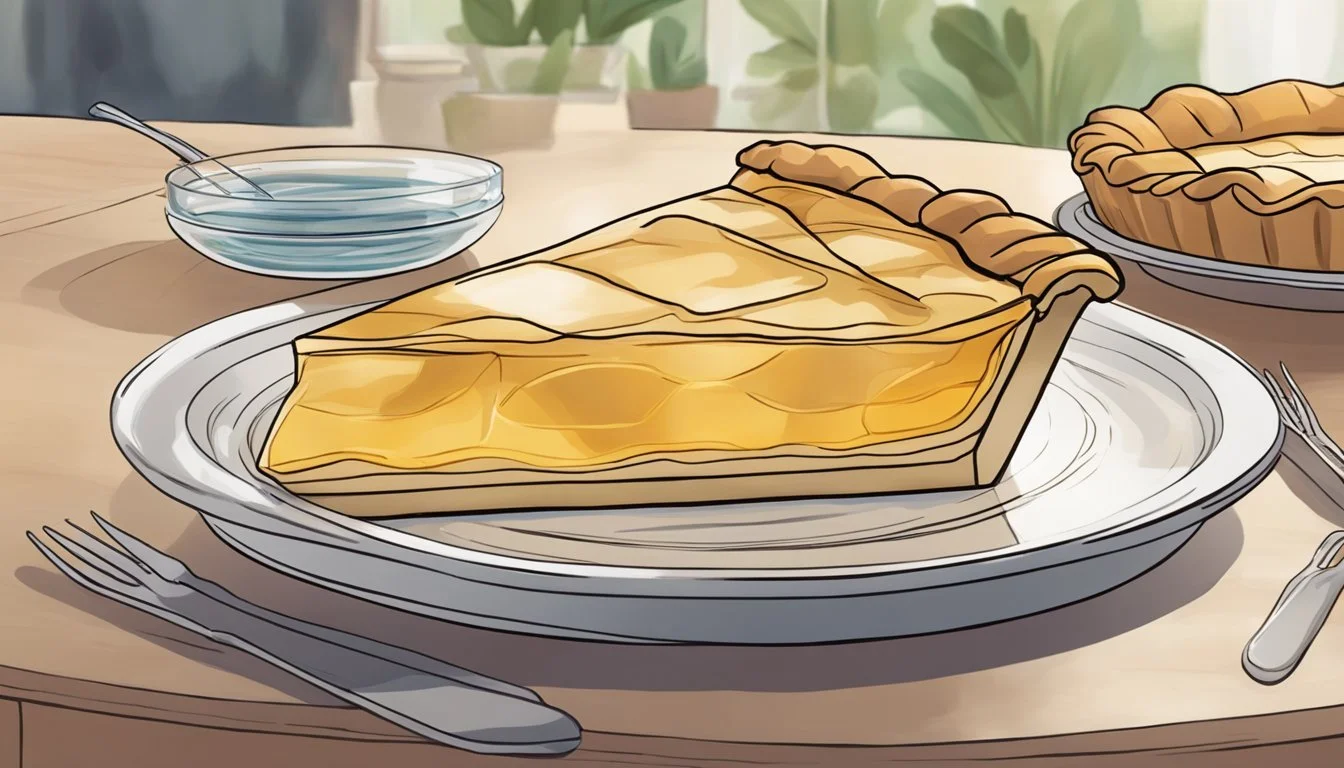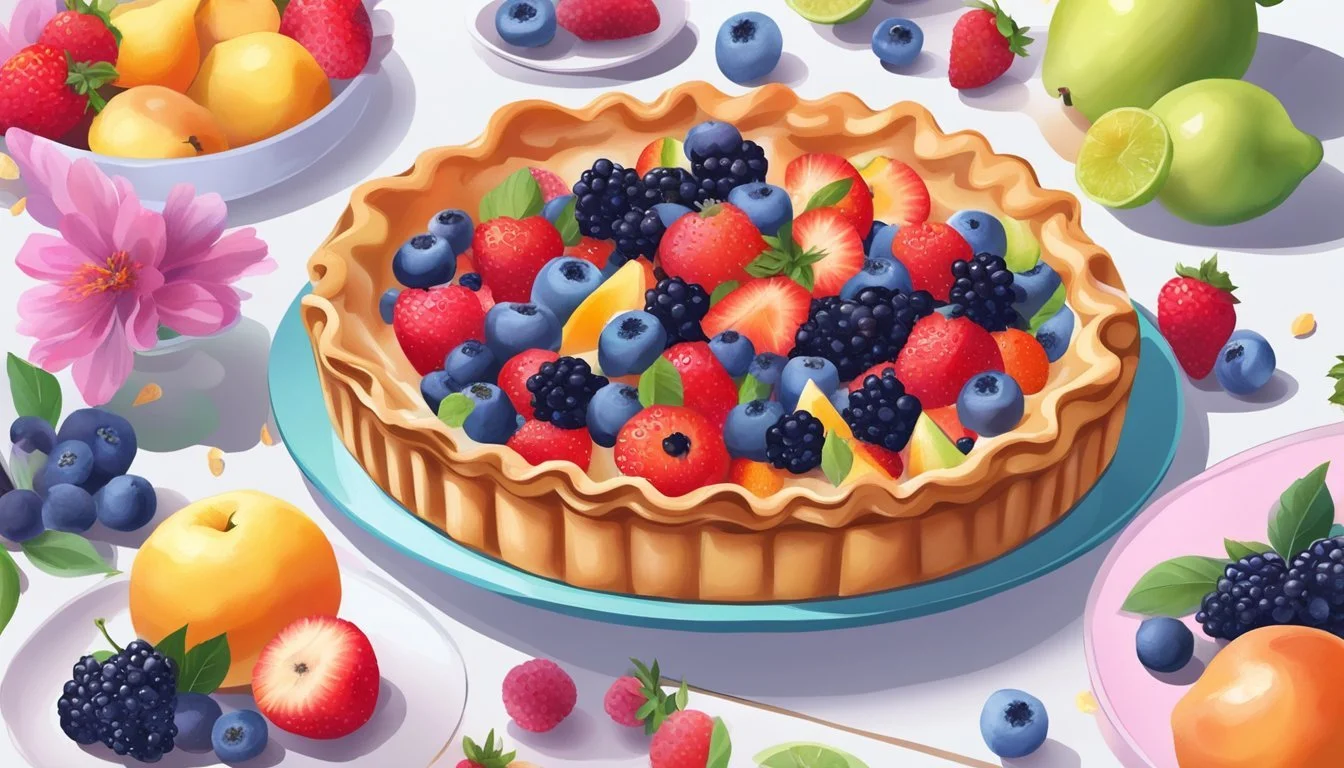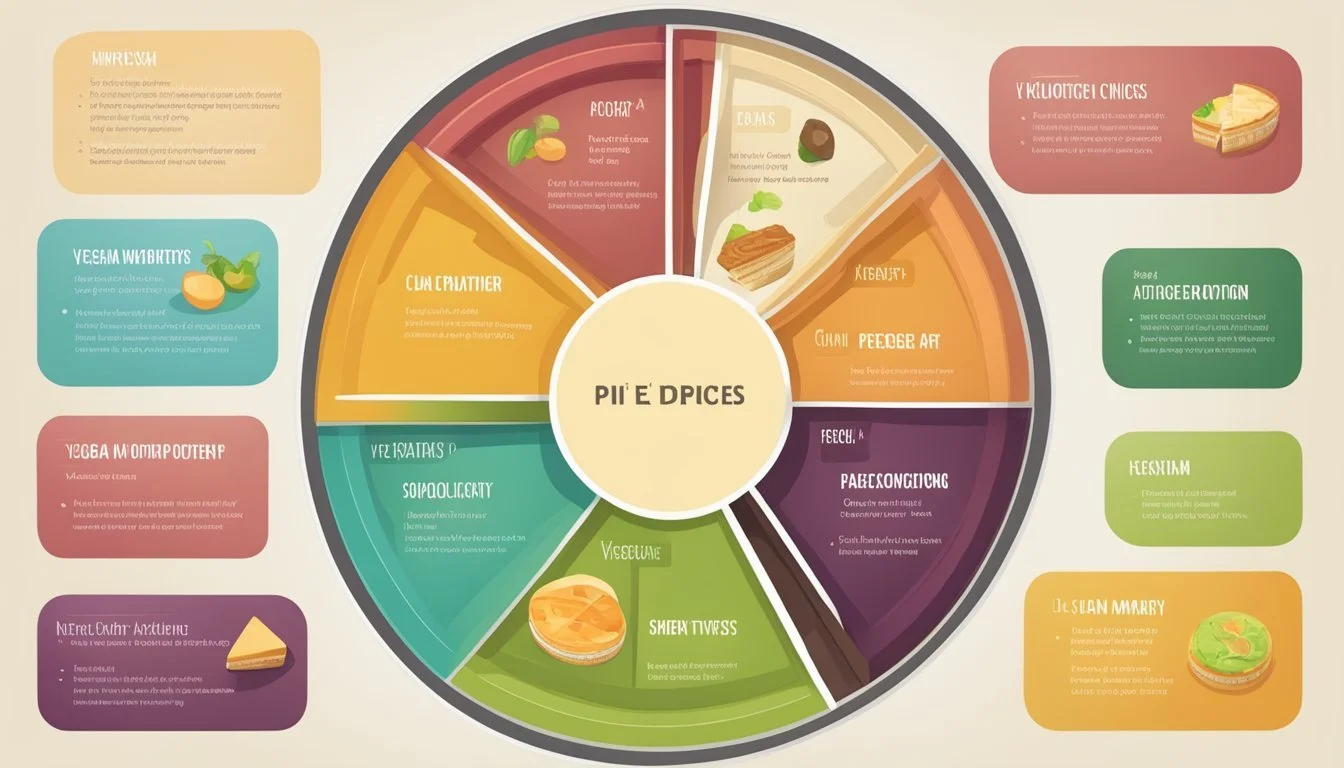Is Transparent Pie Vegan?
Unveiling the Truth About This Classic Dessert
Transparent pie, a dessert steeped in Kentucky tradition, typically includes a variety of non-vegan ingredients, such as eggs, butter, and cream. These components are crucial to creating the pie's characteristic texture – a light, delicate filling with a glossy appearance that gives the pie its name. Renowned for its simplicity, the recipe for transparent pie has been passed down through generations, with the basic ingredients largely remaining the same due to their fundamental role in the pie's structure and flavor.
In considering whether transparent pie can be adapted to a vegan diet, one must examine the availability of plant-based substitutes that can mimic the properties of the original ingredients. The challenge lies in replicating the filling's unique texture, which is largely attributed to the high fat content and structural qualities of eggs and dairy. Vegan baking has made significant strides, offering alternatives such as plant-based milks and butters, as well as binding agents like flaxseed or aquafaba to replace eggs. However, the success of these substitutes in a transparent pie recipe depends on their ability to maintain the pie's signature consistency and taste.
The interest in vegan versions of traditional recipes reflects a growing dietary shift and an increased focus on sustainability and animal welfare. While the classic transparent pie is not vegan, the possibility of creating a vegan-friendly version does exist. This would involve meticulous experimentation with ingredient ratios and baking techniques to achieve a final product that stays true to the essence of the original while aligning with vegan principles.
Understanding Transparent Pie
Transparent pie, a dessert deeply rooted in Kentucky tradition, presents a juxtaposition of simplicity and indulgence through its limited yet opulent ingredients predominantly composed of sugar, butter, and eggs.
Origin and History
The transparent pie hails from Kentucky and has a storied history dating back to the frontier days. It became particularly popular in the Appalachian region, especially in Maysville. The origins of the transparent pie can be traced to a time when pantry staples were scarce, and desserts were made with readily available ingredients. Magee's Bakery in Kentucky is often credited with making the transparent pie widely known.
Main Components
The essential components of transparent pie are quite straightforward, though rich:
Crust: A simple pie shell, often unbaked prior to filling.
Filling: Typically made of sugar, eggs, butter, flour, and cream.
Flavoring: Vanilla extract adds a subtle depth to the sweet filling.
The resulting filling is smooth and jelly-like, setting as it bakes, while the crust provides a contrasting texture.
Common Variations and Relatives
Transparent pie is related to several other pies that share similar traits:
Chess pie: Similar, but may include corn syrup or vinegar.
Jefferson Davis pie: More complex, containing various spices and sometimes dried fruit.
Sugar pie: A simpler version with a focus on the sugar element.
Custard pie: Emphasizes the egg and milk component in its custard.
Pecan pie: Features pecans and often includes corn syrup as well.
It's important to note that while these relatives share a lineage with transparent pie, each has its own unique recipe and flavor profiles that distinguish it from the others.
Is Transparent Pie Vegan?
Transparent pie, traditionally hailing from Kentucky, contains multiple animal-derived ingredients, making it non-vegan. However, with careful substitution, a vegan version can be created.
Identifying Animal-Derived Ingredients
The classic transparent pie is made with ingredients such as eggs, butter, heavy whipping cream, and sometimes lard in the pie crust. These elements are key for creating the characteristic texture and flavor of the pie but are sourced from animals. Specifically:
Eggs are used for binding and adding richness.
Butter contributes to the flaky crust and flavorful filling.
Heavy whipping cream is used to create a light and fluffy texture.
Lard, if used in the crust, aids in creating a tender pastry.
Vegan Substitutes for Traditional Ingredients
Vegan adaptations of transparent pie can be made by substituting plant-based ingredients for their animal-derived counterparts. The substitutions must maintain the structure and taste profile of the original pie as closely as possible. Here are suitable vegan options:
Eggs: Use flaxseed meal mixed with water (1 tablespoon flaxseed with 3 tablespoons water for one egg) or commercial egg substitutes.
Butter: Vegan butter or chilled coconut oil can replace traditional butter to achieve a similar texture in the crust.
Heavy whipping cream: Coconut milk, almond milk, or other non-dairy alternatives can be whipped to create a light texture for the filling.
Lard: Omit or substitute with vegan shortening.
When choosing sugar, ensure it is unrefined or processed without bone char, thereby keeping it vegan. Similarly, opt for cornstarch as a thickener instead of flour to avoid the risk of non-vegan additives.
Making Vegan Transparent Pie
When making a vegan transparent pie, one must choose the right ingredients, prepare the vegan pie crust carefully, and follow specific mixing and baking techniques to achieve the desired outcome.
Selecting the Right Ingredients
To begin, one must gather all vegan-friendly alternatives that match the texture and flavor of traditional ingredients. For the filling, granulated sugar and brown sugar can remain standard, while a dairy-free substitute such as vegan butter replaces regular butter. Vanilla extract is often naturally vegan and essential for adding depth to the pie's flavor.
Table 1: Vegan Substitutes for Transparent Pie Ingredients
Traditional Ingredient Vegan Substitute Butter Vegan butter Eggs Egg replacers or silken tofu Cream Coconut cream or soy milk Corn syrup Agave nectar or maple syrup
These substitutes should be measured in the same quantity as their non-vegan counterparts unless the recipe suggests otherwise.
Preparing Vegan Pie Crust
A crucial step is to prepare a vegan pie crust using all-purpose flour, salt, and dairy-free butter or oil. An effective method is to work the vegan butter into the flour until pebble-sized pieces form. Incorporating ice water gradually creates a pliable dough.
Steps to Prepare Vegan Pie Crust
Blend flour and salt in a large bowl.
Cut in cold vegan butter until mixture resembles coarse crumbs.
Slowly mix in ice water until the dough comes together but is not wet.
Form the dough into a ball, then flatten into a disc and wrap with plastic wrap.
Refrigerate for at least one hour, or until firm.
Once chilled, roll the dough out and place it into a pie plate. To partially bake the crust, line it with parchment paper, fill with pie weights, and bake in a preheated oven until the edges are golden brown.
Mixing and Baking Techniques
For the filling, combine the selected sugars with melted vegan butter, whisking until well mixed. Incorporate your choice of thickener and vegan flavorings, such as vanilla, and mix until smooth. Ensure no lumps remain, and that the consistency is even throughout.
Baking Techniques Checklist
Preheat oven to the correct temperature.
Pour the filling into the frozen or refrigerated crust.
Place the pie plate on a baking sheet to catch any drippings.
Bake until the filling is set and the surface is a consistent golden brown.
Allow the baked pie to cool to room temperature before slicing.
If not serving immediately, cover and refrigerate to maintain freshness.
By adhering to these specifics, one can create a delicious vegan transparent pie that mirrors the qualities of its traditional counterpart.
Transparent Pie in Modern Cuisine
Transparent pie, a sweet treat rooted in the culinary traditions of Maysville, Kentucky, continues to delight both family gatherings and holiday festivities. Its simple yet satisfying nature makes it a staple in the realm of regional desserts, especially within Appalachia.
Geographical Popularity and Culinary Significance
Transparent pie's lineage in Maysville, Kentucky, carries with it a touch of celebrity, often linked to George Clooney, whose family hails from the area. Known for its smooth, jelly-like custard filling, transparent pie has grown from a regional delicacy to a comfort food known beyond the Appalachian borders. It embodies simplicity and resourcefulness, as the original recipe emerged from the constraints of ingredient availability, utilizing essentials like eggs, butter, and sugar.
In Maysville and surrounding areas, transparent pie symbolizes a bridge to the past, representing a dessert that has been passed down through generations. The appeal of this quintessentially Kentuckian pie has not faded over time, maintaining its position as a beloved family dessert during the holidays, but also finding appreciation among guests as a novel treat.
Pairings and Serving Suggestions
Pairings for Transparent Pie:
Whipped Cream: A classic, fluffy complement to the rich filling
Ice Cream: Ideally vanilla, for a meld of warmth and cold
Nuts: Pecans or walnuts add a crunchy texture contrast
Spices: A sprinkle of cinnamon enhances the overall flavor
Serving Suggestions:
Temperature: Serve warm or at room temperature to emphasize its custardy core
Fruit Pies: Offer alongside fruit pies for a varied dessert experience
Although the transparent pie is not inherently vegan due to the use of dairy and eggs, it maintains popularity during gatherings where dietary preferences vary. Innovations in modern cuisine could adapt its traditional non-vegan components to cater to a broader audience while preserving its essence.
Understanding Vegan Dietary Choices
In the context of veganism, the choices one makes are grounded in health and ethical considerations, often leading to misconceptions and challenges.
Health and Ethical Considerations
Vegans opt for a plant-based diet, primarily for wellness benefits and ethical eating practices. Health benefits are a significant driver, with vegans often experiencing lower rates of heart disease, obesity, and some types of cancer. Their dietary choices exclude all animal products, focusing on non-dairy options, fruits, vegetables, legumes, grains, nuts, and seeds. Ethically, veganism embodies a lifestyle that seeks to exclude, as far as possible, all forms of exploitation and cruelty to animals, often extending beyond diet to include avoidance of animal-derived products across all aspects of life.
Misconceptions and Challenges
Challenges in a vegan diet include ensuring adequate intakes of certain nutrients typically abundant in animal products such as protein, iron, Omega-3 fatty acids, calcium, and vitamin B12. Misconceptions arise around the idea that vegans have limited food choices, when in fact, they can enjoy a diverse and satisfying range of meals. One challenge vegans may face is navigating social and dining scenarios that are not tailored to their dietary restrictions. Education and awareness are vital as they clarify the differences between veganism as a comprehensive ethical choice and simple plant-based eating, which may only encompass dietary choices.
Storage and Preservation
When it comes to storing and preserving Transparent pie, the focus is on maintaining its freshness and quality for as long as possible. Appropriate storage techniques can extend the shelf life and ensure that the pie retains its intended flavor and texture.
Longevity and Quality Maintenance
To preserve the freshness of a Transparent pie, it should be stored in the refrigerator if it will not be consumed within two days. The pie should be covered with plastic wrap or aluminum foil to prevent it from absorbing any odors and to keep it moist. It's important to note that the shelf life of a Transparent pie in the refrigerator is typically 3 to 4 days. For those with a deep dish pie, make sure to cover the edges to prevent them from drying out.
Refrigerator Storage:
Cover with plastic wrap or aluminum foil.
Consume within 3 to 4 days.
Tips for Freezing and Reheating
Transparent pies can be frozen for longer preservation. To freeze, wrap the pie tightly with plastic wrap or aluminum foil, or place it in a freezer-safe container. For best results, one should freeze the pie in a deep dish pan to retain its shape. Frozen crust can also be stored separately. Pie can be kept in the freezer for up to two months.
To reheat, one does not need to thaw the pie; it can go straight from the freezer to the oven. Preheat the oven to 350°F and bake until the pie is heated through. This could take approximately 30 minutes, but one should check the pie regularly to prevent overbaking.
Freezing:
Wrap tightly in plastic wrap or aluminum foil.
Store for up to 2 months.
Reheating From Frozen:
Preheat oven to 350°F.
Bake until heated through, checking regularly.
Additional Vegan Desserts and Alternatives
Seeking vegan dessert options doesn't limit one to a narrow selection. On the contrary, it opens up a world of creative plant-based alternatives for everything from rich chocolate cakes to classic pies. This section explores reliable vegan-friendly baking recipes and methods for adapting non-vegan recipes to meet vegan standards.
Vegan-Friendly Baking Recipes
For those who enjoy crafting desserts from scratch, vegan baking recipes provide a satisfying avenue to explore. Vegan brownies can be made to rival any traditional recipe by using substitutions like plant-based milk and vegan butter, ensuring a moist crumb without any dairy. Another popular choice is a Vegan Chocolate Cake, which employs ingredients like dairy-free chocolate and a dairy substitute, to achieve a tender, moist texture that pleases any palate.
Vegan pies stand out as a delightful category of vegan desserts and Vegan Banana Cream Pie demonstrates this with its crispy gluten-free crust and silky cream center made from plant-based alternatives.
No-bake vegan pies also deserve mention, with options like the No Bake Vegan PB&J Pie, which is not only vegan but also naturally sweetened. It requires minimal preparation, forgoing the oven entirely, save for the crust.
Saucepan creations, such as sugar-free syrups and vegan caramel, show that stove-top desserts and accompaniments are equally viable.
Adapting Non-Vegan Recipes
Transforming non-vegan desserts into vegan-friendly delights may seem daunting, but a few simple swaps can make any recipe plant-based. Many pastries that traditionally call for butter can be made vegan by using a vegan butter substitute, which performs comparably in baking and cooking. In the realm of sauces or fillings, dairy can be replaced with cashew cream or coconut milk, while cornstarch serves as an effective thickening agent in place of eggs.
Apple pie can be easily veganized by swapping the butter in the crust for a plant-based alternative and ensuring the pastry is free from animal-based shortening.
Vegan chocolate desserts (What wine goes well with chocolate desserts?) benefit from the availability of high-quality dairy-free chocolate, making it simple to recreate any chocolatey confection sans animal products.
By using these substitutes, one can adapt nearly any dessert recipe to fit a vegan diet, resulting in pastries, pies, and cakes that are both indulgent and inclusive of vegan dietary preferences.









